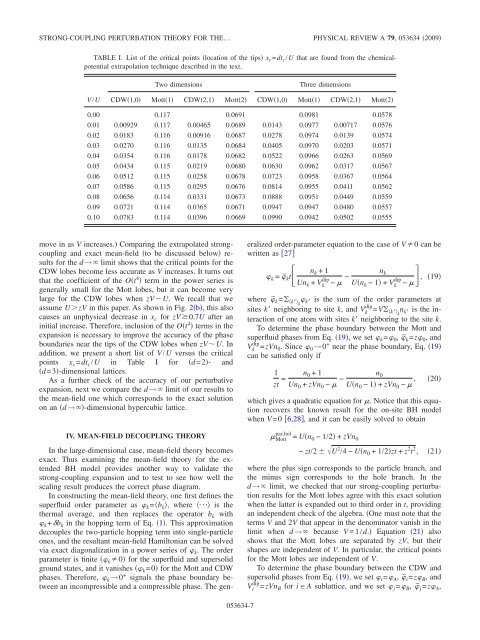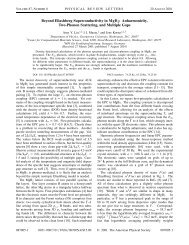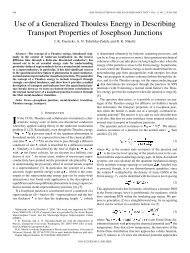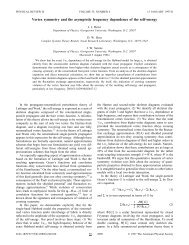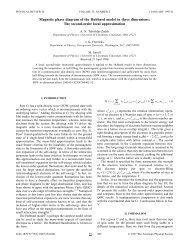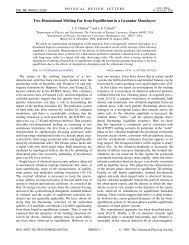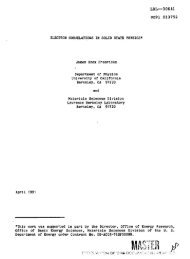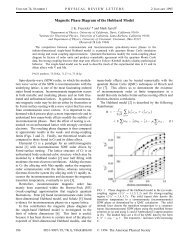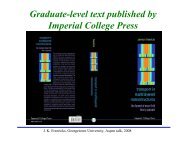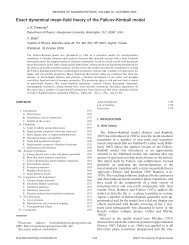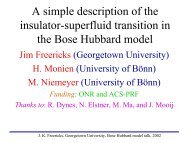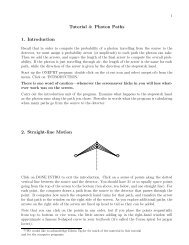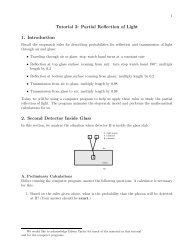Strong-coupling perturbation theory for the extended Bose-Hubbard ...
Strong-coupling perturbation theory for the extended Bose-Hubbard ...
Strong-coupling perturbation theory for the extended Bose-Hubbard ...
Create successful ePaper yourself
Turn your PDF publications into a flip-book with our unique Google optimized e-Paper software.
STRONG-COUPLING PERTURBATION THEORY FOR THE…<br />
PHYSICAL REVIEW A 79, 053634 2009<br />
TABLE I. List of <strong>the</strong> critical points location of <strong>the</strong> tips x c =dt c /U that are found from <strong>the</strong> chemicalpotential<br />
extrapolation technique described in <strong>the</strong> text.<br />
Two dimensions<br />
Three dimensions<br />
V/U<br />
CDW1,0 Mott1 CDW2,1 Mott2 CDW1,0 Mott1 CDW2,1 Mott2<br />
0.00 0.117 0.0691 0.0981 0.0578<br />
0.01 0.00929 0.117 0.00465 0.0689 0.0143 0.0977 0.00717 0.0576<br />
0.02 0.0183 0.116 0.00916 0.0687 0.0278 0.0974 0.0139 0.0574<br />
0.03 0.0270 0.116 0.0135 0.0684 0.0405 0.0970 0.0203 0.0571<br />
0.04 0.0354 0.116 0.0178 0.0682 0.0522 0.0966 0.0263 0.0569<br />
0.05 0.0434 0.115 0.0219 0.0680 0.0630 0.0962 0.0317 0.0567<br />
0.06 0.0512 0.115 0.0258 0.0678 0.0723 0.0958 0.0367 0.0564<br />
0.07 0.0586 0.115 0.0295 0.0676 0.0814 0.0955 0.0411 0.0562<br />
0.08 0.0656 0.114 0.0331 0.0673 0.0888 0.0951 0.0449 0.0559<br />
0.09 0.0721 0.114 0.0365 0.0671 0.0947 0.0947 0.0480 0.0557<br />
0.10 0.0783 0.114 0.0396 0.0669 0.0990 0.0942 0.0502 0.0555<br />
move in as V increases. Comparing <strong>the</strong> extrapolated strong<strong>coupling</strong><br />
and exact mean-field to be discussed below results<br />
<strong>for</strong> <strong>the</strong> d→ limit shows that <strong>the</strong> critical points <strong>for</strong> <strong>the</strong><br />
CDW lobes become less accurate as V increases. It turns out<br />
that <strong>the</strong> coefficient of <strong>the</strong> Ot 4 term in <strong>the</strong> power series is<br />
generally small <strong>for</strong> <strong>the</strong> Mott lobes, but it can become very<br />
large <strong>for</strong> <strong>the</strong> CDW lobes when zVU. We recall that we<br />
assume UzV in this paper. As shown in Fig. 2b, this also<br />
causes an unphysical decrease in x c <strong>for</strong> zV0.7U after an<br />
initial increase. There<strong>for</strong>e, inclusion of <strong>the</strong> Ot 4 terms in <strong>the</strong><br />
expansion is necessary to improve <strong>the</strong> accuracy of <strong>the</strong> phase<br />
boundaries near <strong>the</strong> tips of <strong>the</strong> CDW lobes when zVU. In<br />
addition, we present a short list of V/U versus <strong>the</strong> critical<br />
points x c =dt c /U in Table I <strong>for</strong> d=2- and<br />
d=3-dimensional lattices.<br />
As a fur<strong>the</strong>r check of <strong>the</strong> accuracy of our perturbative<br />
expansion, next we compare <strong>the</strong> d→ limit of our results to<br />
<strong>the</strong> mean-field one which corresponds to <strong>the</strong> exact solution<br />
on an d→-dimensional hypercubic lattice.<br />
IV. MEAN-FIELD DECOUPLING THEORY<br />
In <strong>the</strong> large-dimensional case, mean-field <strong><strong>the</strong>ory</strong> becomes<br />
exact. Thus examining <strong>the</strong> mean-field <strong><strong>the</strong>ory</strong> <strong>for</strong> <strong>the</strong> <strong>extended</strong><br />
BH model provides ano<strong>the</strong>r way to validate <strong>the</strong><br />
strong-<strong>coupling</strong> expansion and to test to see how well <strong>the</strong><br />
scaling result produces <strong>the</strong> correct phase diagram.<br />
In constructing <strong>the</strong> mean-field <strong><strong>the</strong>ory</strong>, one first defines <strong>the</strong><br />
superfluid order parameter as k =b k , where ¯ is <strong>the</strong><br />
<strong>the</strong>rmal average, and <strong>the</strong>n replaces <strong>the</strong> operator b k with<br />
k +b k in <strong>the</strong> hopping term of Eq. 1. This approximation<br />
decouples <strong>the</strong> two-particle hopping term into single-particle<br />
ones, and <strong>the</strong> resultant mean-field Hamiltonian can be solved<br />
via exact diagonalization in a power series of k . The order<br />
parameter is finite k 0 <strong>for</strong> <strong>the</strong> superfluid and supersolid<br />
ground states, and it vanishes k =0 <strong>for</strong> <strong>the</strong> Mott and CDW<br />
phases. There<strong>for</strong>e, k →0 + signals <strong>the</strong> phase boundary between<br />
an incompressible and a compressible phase. The generalized<br />
order-parameter equation to <strong>the</strong> case of V0 can be<br />
written as 27<br />
k = ¯ kt<br />
n k +1<br />
Un k + V k dip − −<br />
n k<br />
Un k −1 + V k dip − , 19<br />
where ¯ k= k k<br />
k is <strong>the</strong> sum of <strong>the</strong> order parameters at<br />
sites k neighboring to site k, and V k dip =V k k<br />
n k is <strong>the</strong> interaction<br />
of one atom with sites k neighboring to <strong>the</strong> site k.<br />
To determine <strong>the</strong> phase boundary between <strong>the</strong> Mott and<br />
superfluid phases from Eq. 19, weset k = 0 , ¯ k=z 0 , and<br />
V k dip =zVn 0 . Since 0 →0 + near <strong>the</strong> phase boundary, Eq. 19<br />
can be satisfied only if<br />
1<br />
zt = n 0 +1<br />
Un 0 + zVn 0 − − n 0<br />
Un 0 −1 + zVn 0 − ,<br />
20<br />
which gives a quadratic equation <strong>for</strong> . Notice that this equation<br />
recovers <strong>the</strong> known result <strong>for</strong> <strong>the</strong> on-site BH model<br />
when V=0 6,28, and it can be easily solved to obtain<br />
par,hol Mott = Un 0 −1/2 + zVn 0<br />
− zt/2 U 2 /4−Un 0 +1/2zt + z 2 t 2 ,<br />
21<br />
where <strong>the</strong> plus sign corresponds to <strong>the</strong> particle branch, and<br />
<strong>the</strong> minus sign corresponds to <strong>the</strong> hole branch. In <strong>the</strong><br />
d→ limit, we checked that our strong-<strong>coupling</strong> <strong>perturbation</strong><br />
results <strong>for</strong> <strong>the</strong> Mott lobes agree with this exact solution<br />
when <strong>the</strong> latter is expanded out to third order in t, providing<br />
an independent check of <strong>the</strong> algebra. One must note that <strong>the</strong><br />
terms V and 2V that appear in <strong>the</strong> denominator vanish in <strong>the</strong><br />
limit when d→ because V1/d. Equation 21 also<br />
shows that <strong>the</strong> Mott lobes are separated by zV, but <strong>the</strong>ir<br />
shapes are independent of V. In particular, <strong>the</strong> critical points<br />
<strong>for</strong> <strong>the</strong> Mott lobes are independent of V.<br />
To determine <strong>the</strong> phase boundary between <strong>the</strong> CDW and<br />
supersolid phases from Eq. 19, weset i = A , ¯ i=z B , and<br />
V i dip =zVn B <strong>for</strong> iA sublattice, and we set j = B , ¯ j=z A ,<br />
053634-7


